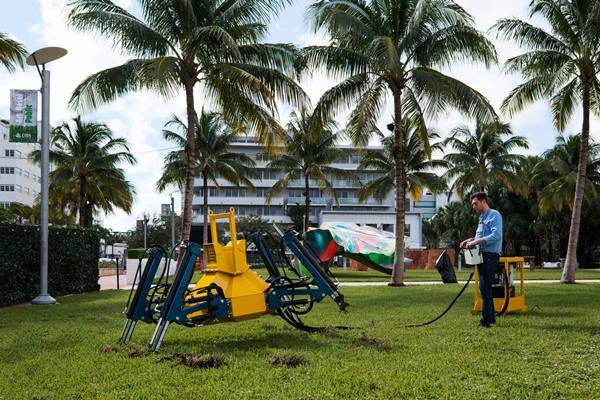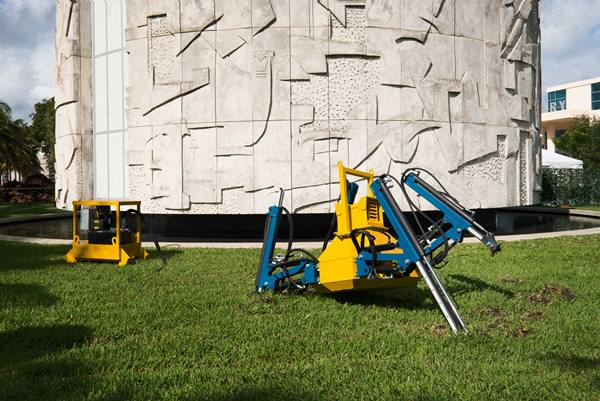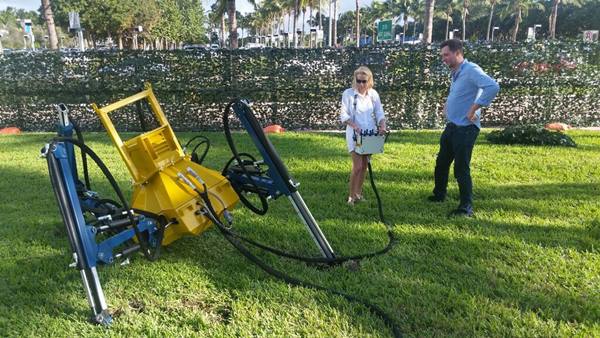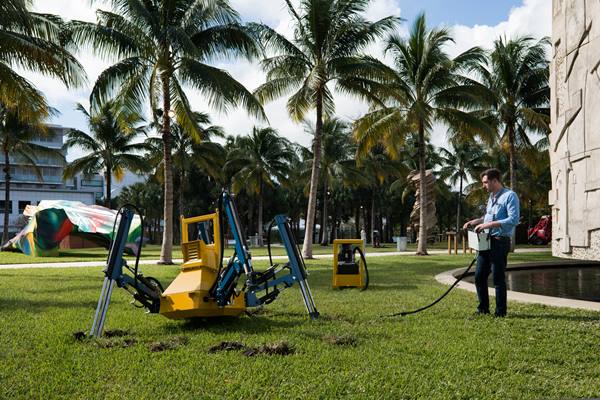Art Fairs
James Capper Does Serious Tricks With a 2,000-Pound Sculpture in Miami
His hydraulic-powered, interactive sculpture is a joy to behold.

Image: Courtesy of Paul Kasmin Gallery.
His hydraulic-powered, interactive sculpture is a joy to behold.

Laura van Straaten

“I can make it do a spinning thing on its belly,” says artist James Capper as he demonstrates the features of his hydraulic-powered, interactive sculpture Mountaineer Prototype (2015). “It’s like an infant.”
He then hoists the sculpture’s unwieldy control box around my neck. The 28-year-old artist has agreed to let me try my hand at making his 2,000-pound piece’s four telescopic legs sculpture “walk” about Miami Beach’s Collins Park, where it is on view among more than 25 other works as part of the Art Basel Miami’s Public Sector, curated by Nicholas Baume of New York City’s Public Art Fund.
I was a kid who favored stuffed animals and storybooks over trucks, diggers, sci-fi or robots. But I still got a sense of wonder from interacting with the sculpture, painted as it is in school-bus yellow and a Fisher Price blue that Capper says he favors “to get away from Star Wars and the military.” Baume popped by just as Capper was letting me give the sculpture a whirl, describing Public Sector as “the idea of taking forms we are familiar with in everyday life and re-inventing them as something new and surprising.”
In fact, Capper’s piece turns out to have loomed larger in my imagination than it does in real life. It is smaller than any of the Louise Bourgeois spiders I’ve seen, though immediately evocative of their spindly legs and potbelly torsos. But Capper’s piece, which is an operational prototype of a much larger one yet to be built, is dwarfed by artist Tony Tasset’s Brontosaurs-scaled deer lawn ornament, placed just steps away from the Bass Museum.

James Capper, Mountaineer Prototype (2015).
Image: Courtesy of Paul Kasmin Gallery.
Wearing the control box felt like wearing a necklace whose dangly charm is a toaster oven, the kind you can roast a whole chicken in. I fiddled with each of the eight joysticks—marked with labels like DIPPER IN, STEER LEFT, BOOM UP, BOOM DOWN, etc. I tried to move several joysticks in concert to see if I could make the machine walk; this was, I learned, akin to picking up a musical instrument you’ve never touched before and hoping to play a specific tune, in this case a duet for which I was missing a second set of hands. Capper leaned in to help me.
Perhaps it is related to my lifelong failure to drive a stick car properly, but I was not able to make the sculpture take a single step, even with a limp. With Capper’s help, I did get it to crouch and do what yogis might call a cat stretch. And I enjoyed making the legs scratch up clods of clover-covered sod. Capper was a trooper, never once wincing as I maneuvered his very expensive sculpture about in the dirt, nearly tumbling it over at one point.

Laura van Straaten attempts to operate Mountaineer Prototype (2015).
Image: Courtesy of the author.
The artist’s work will be familiar to those who saw his amphibious sculpture Six Step (2015) at the Rio dell’Orso project space during this year’s Venice Biennale. Capper, who received his MA in Sculpture from London’s Royal College of Art five years ago, has already had solo exhibitions at the Yorkshire Sculpture Park, Modern Art Oxford, London’s Hannah Barry Gallery and Paul Kasmin New York (whose booth at Art Basel this weeks will show the artist’s drawings).
The artist sees all elements of each machine as a holistic artwork: the wearable control panel; what most people will think of as “the sculpture” with its insect-like belly on its four legs; the thick black cords which tether everything to the 500-pound “powerpack,” which motors the movable sculpture. He thinks of his machines as falling into four relatively “divisions,” as he calls them: Offshore, Carving, Material Handling and Earth-Marking. He situates Mountaineer Prototype in Earth-Marking, which includes machines that mark the land they occupy with divots and gouges, transforming varying turfs into rutted canvasses. The links to and breaks from 1970s Land Art are evident, as are the long shadows of artists like Matthew Barney and Chris Burden.

James Capper, Mountaineer Prototype (2015).
Image: Courtesy of Paul Kasmin Gallery.
None of my failings in making Capper’s sculpture “walk” make the work any less delightful or significant an achievement in engineering. I asked the artist how he feels if a machine, once he’s built it, doesn’t do what he intended. “You only lose if you never get the idea into reality and try,” he said. “Art world people accept that what I’m doing has integrity.”
For Capper, there is no shame in a touch of futility in the search for utility.
Mountaineer Prototype will be positioned in front of the Bass Museum at 2100 Collins Ave. through December 6. The artist will engage with the work in person during performances on Wednesday, December 2 from 7 pm to 9 pm (open to exhibitors and VIP guests) and Thursday, December 3, from 7 pm to 9 pm (open to all).